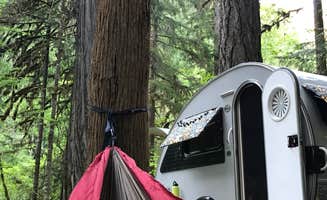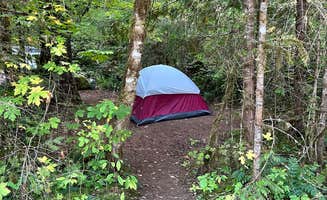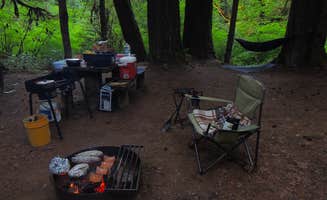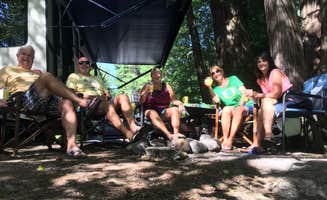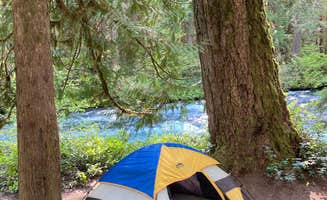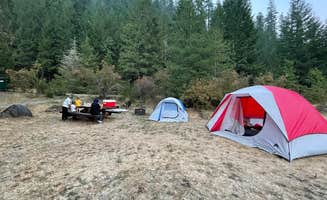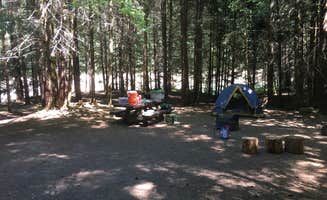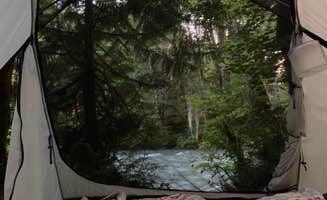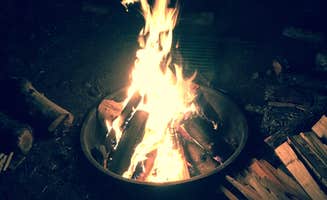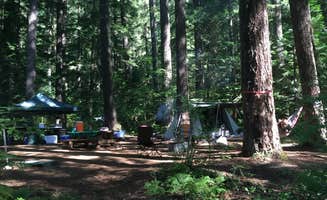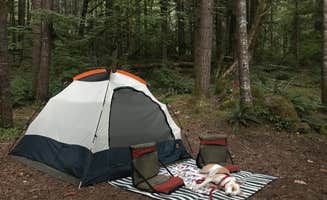Willamette National Forest campgrounds stretch across a landscape of diverse elevations, ranging from 1,500 to 5,800 feet above sea level. The area encompasses over 1.6 million acres with more than 40 developed campgrounds, many positioned along waterways that provide natural temperature regulation during summer months. Water temperatures in these mountain streams remain cold year-round, with Clear Lake maintaining a consistent 38-degree temperature regardless of season.
What to do
Explore volcanic landscapes: The McKenzie River corridor features dramatic lava formations. At Coldwater Cove Campground, visitors can discover the geological history up close. "This is an excellent campground on Clear Lake. There is accessibility to the lake, but it's down a steep lava rock path," notes one camper. The campground is built on a lava flow that dammed the McKenzie River, creating Clear Lake.
Paddle crystal waters: Blue River Reservoir offers calm waters for kayakers and paddleboarders. "Absolutely a beautiful spot tucked away! Off the main road with a few dispersed spots spaced out very nicely. Not the easiest access to the river but if able easy enough," reports a visitor to Blue River Reservoir Roadside Camping. For those seeking rental options, Clear Lake provides rowboat rentals at reasonable rates.
Hike to waterfalls: Multiple trails lead to cascades throughout the region. "Short hiking trails here and lots more closeby. You can hear the water from your tent at night!" shares a camper from Paradise In Oregon. The area contains multiple waterfall trails, including Proxy Falls near Limberlost Campground, which features two beautiful falls and a walk through lava beds.
What campers like
River access sites: Waterfront camping spots offer direct water views. "Site 17 is perfect and has river access in the back! Campground is clean, bathrooms are clean, the host is really cool," reports a camper from Paradise In Oregon. River-adjacent sites fill quickly during peak seasons, particularly those with direct water access.
Natural privacy buffers: Many campsites feature tree separation between sites. "We stayed at Paradise with a big group spread over multiple campsites. We used 33 as our gathering spot and it was awesome. Room for several tents on nice flat spots, not too close to adjacent sites with drinking water just across from parking," notes a visitor to McKenzie Bridge Trailhead.
Diverse accommodation options: The region offers everything from tent sites to cabins. At Belknap Hot Springs, "Great for any kind of camper or non-camper. Tents, RVs, cabins, the lodge, they have it all. Staff is friendly and the hot spring pools are wonderful. We have tent camped here and have rented a cabin and had a great experience both times," shares one reviewer.
What you should know
Site dimensions vary significantly: Many campgrounds feature uneven site sizes. "Large private sites, beautiful river, and really nice mountain biking. What more could you ask for," reports a camper about Paradise In Oregon. However, at Limberlost Campground, "Each spot is quite unique and offer a decent amount of privacy and aren't right on top of each other."
Water quality concerns: Some campgrounds have questionable drinking water. At Olallie Campground, "the 'potable' water was very iffy. When I stayed there (May of 2021) the water was a gross yellow and the test results hadn't come back for it. Honestly I wouldn't have drank it no matter what the test results said!" Bringing supplemental drinking water is advisable.
Seasonal water levels: Reservoirs fluctuate dramatically throughout the year. "We camped the first weekend of September and the reservoir was empty. We were really disappointed since we chose this campground so we could fish and swim," notes a visitor to Lookout Campground. Water levels drop significantly in late summer and early fall.
Tips for camping with families
Best sites for kids: Certain campgrounds offer child-friendly amenities. "Perfect basecamp... mix of tent sites including some walk-ins that are up against the reservoir- you can hear the peaceful running water all day and night. Brand new picnic tables, brand new fencing, and excellent trails," notes a visitor to Ice Cap Campground.
Wildlife viewing opportunities: Children can observe native species in their habitats. "The morning kayak was on an absolutely flat glass lake. The lake is super clean, but a frigid 38 degrees. There is a petrified forest under the water from the way the lake was formed by a volcanic eruption," shares a Coldwater Cove camper. Morning hours provide optimal wildlife viewing conditions.
Swimming considerations: Water temperatures remain extremely cold year-round. "Swimming is not permitted for this reason," warns a Coldwater Cove camper about Clear Lake. Parents should monitor children closely near water and consider bringing alternative water activities that don't require full immersion.
Tips from RVers
Site accessibility challenges: Many campgrounds have limited RV capacity. "I often pull my pig of a trailer (25') so comment based on those experiences. I got into this campsite late and just needed a place to park the pig. I still had to stop and walk into numerous sites before I found one that could safely accommodate the pig," shares a visitor to McKenzie Bridge Campground.
Road restrictions: Certain routes prohibit larger vehicles. "Hwy 242 is one of the most amazing discoveries I made this trip. However, this is NOT a road for RV's of any kind. There is NO wiggle room as this extremely narrow 'highway' was carved through lava fields and those lava walls are literally inches off the edge of the road," cautions a McKenzie Bridge Campground visitor. Alternative routes should be researched.
Reservoir access: Some campgrounds offer boat launching facilities. "We were at site 15 which was all the way at the end and was nicely secluded from the rest of the sites. We had direct access to the lake, but it looks like if the lake was low it would be a climb to get down to the water," notes a visitor to Lookout Campground. Water levels affect accessibility throughout the season.


